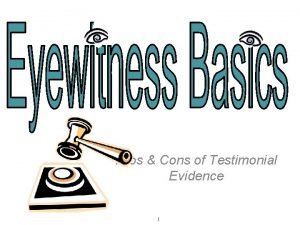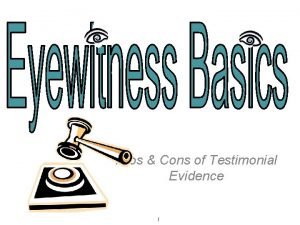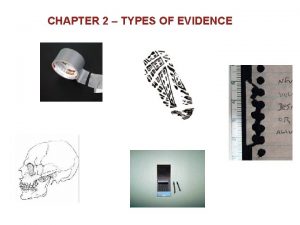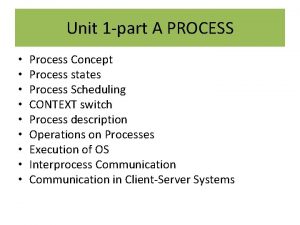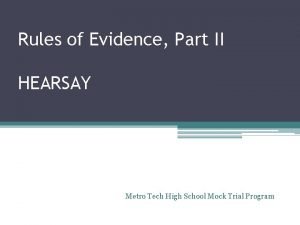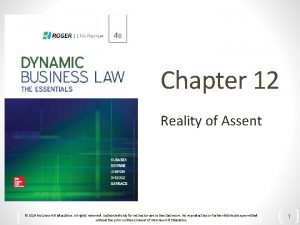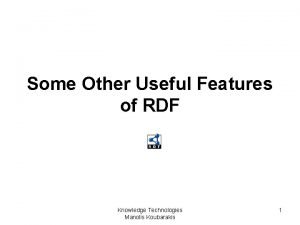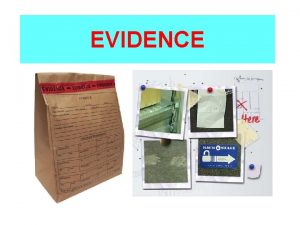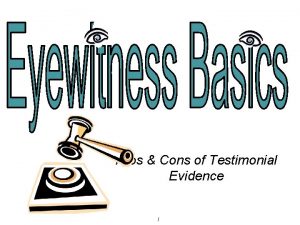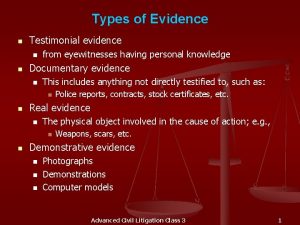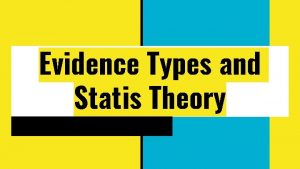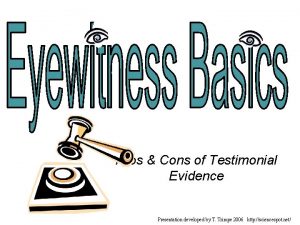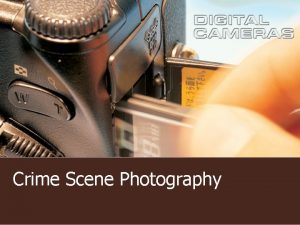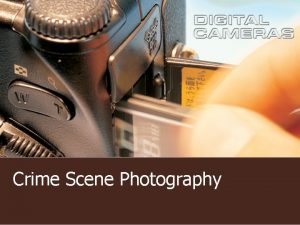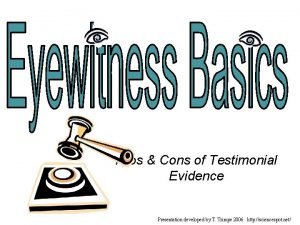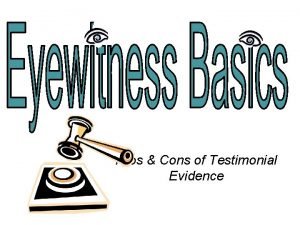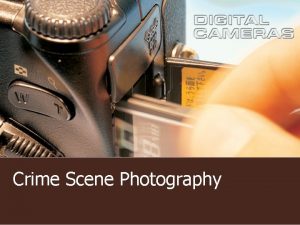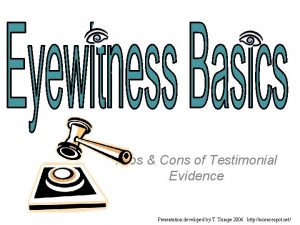EVIDENCE CLASSIFICATION OF EVIDENCE Testimonial Evidence statement made






















- Slides: 22

EVIDENCE

CLASSIFICATION OF EVIDENCE Testimonial Evidence: statement made under oath direct evidence eyewitness evidence* Physical evidence: any object or material that is relevant in a crime “real” evidence Examples: hair, fiber, fingerprints, documents, blood, soil, drugs, toolmarks, impressions, glass physical and chemical properties

RELIABILITY OF EYEWITNESSES Factors that affect accuracy: Nature of the offense and the situation in which the crime is observed Characteristics of the witness Manner in which the information is retrieved Additional factors: Witness’s prior relationship with the accused Length of time between the offense and the identification Any prior identification or failure to identify the defendant Any prior identification of a person other than the defendant by the eyewitness

PHYSICAL EVIDENCE • Is generally more reliable than testimonial evidence • Can prove that a crime has been committed • Can corroborate or refute testimony • Can link a suspect with a victim or with a crime scene • Can establish the identity of persons associated with a crime • Can allow reconstruction of events of a crime

RECONSTRUCTION • Physical evidence can be used to answer questions about: What took place at a crime scene The number of people involved The sequence of events • A forensic scientist compares the questioned (Q) (unknown) sample from the crime scene with a sample of known (K) origin.

TYPES OF PHYSICAL EVIDENCE • Transient evidence • Pattern evidence • Conditional evidence • Transfer evidence • Associative evidence

TRANSIENT EVIDENCE • Temporary • Easily changed or lost • Usually observed by the first officer at the scene. • Examples: Odor—putrefaction, perfume, gasoline, urine, burning, explosives, cigarette or cigar smoke Temperature—surroundings, car hood, coffee, water in a bathtub, cadaver Imprints and indentations— footprints, teeth marks in perishable foods, tire marks on certain surfaces

PATTERN EVIDENCE • Produced by direct contact between a person and an object or between two objects • Mostly in the form of imprints, indentations, striations, markings, fractures, or deposits Blood spatter Glass fracture Fire burn pattern Furniture position Projectile trajectory Tire marks or skid marks Clothing or article distribution Gunpowder residue Material damage Body position Toolmarks Modus operandi

PATTERN EVIDENCE

CONDITIONAL EVIDENCE • Produced by a specific event or action • Important in crime scene reconstruction, determining circumstances or event sequence • indirect evidence Smoke—color, direction of travel, density, odor Vehicles—doors locked or unlocked, windows opened or closed, radio off or on, odometer mileage Fire—color and direction of the flames, speed of spread, temperature and condition of fire Body—position and types of wounds; rigor, livor, and algor mortis Location—of injuries or wounds, of bloodstains, of the victim’s vehicle, of weapons or cartridge cases, of broken glass Scene—condition of furniture, doors and windows, any disturbance or signs of a struggle Light—headlight, lighting conditions, lights on or off


TRANSFER EVIDENCE • Produced by contact between person(s) and object(s), or between person(s) and person(s).

ASSOCIATIVE EVIDENCE • Something that may associate a victim or suspect with a scene or with each other; e. g. , personal belongings.

CLASSIFICATION OF EVIDENCE BY NATURE • Biological—blood, semen, saliva, sweat, tears, hair, bone, tissues, urine, feces, animal material, insects, bacteria, fungi, botanical material • Chemical—fibers, glass, soil, gunpowder, metals, minerals, narcotics, drugs, paper, ink, cosmetics, paint, plastic, lubricants, fertilizer • Physical—fingerprints, footprints, shoeprints, handwriting, firearms, tire marks, tool marks, typewriting • Miscellaneous—laundry marks, voice analysis, polygraph, photography, stress evaluation, psycholinguistic analysis, vehicle identification

INDIVIDUAL VS. CLASS EVIDENCE • Individual—can be identified with a particular person or a single source • Class—common to a group of objects or persons • relies on statistics! Fingerprints Blood DNA Typing

INDIVIDUAL VS. CLASS EVIDENCE These fibers are class evidence; there is no way to determine if they came from this garment. The large piece of glass fits exactly to the bottle; it is individual evidence.

INDIVIDUAL VS. CLASS EVIDENCE Which examples do you think could be individual evidence?

STEPS IN A FORENSIC INVESTIGATION 1. Recognition 2. Preservation 3. Identification 4. Comparison 5. Individualization 6. Interpretation 7. Reconstruction

STEPS IN A FORENSIC INVESTIGATION 1. Recognition of evidence the ability to distinguish important evidence from unrelated material pattern recognition physical property observation information analysis field testing 2. Preservation of evidence collection proper packaging

STEPS IN A FORENSIC INVESTIGATION 3. Identification of evidence: scientific testing of… physical/chemical properties morphology biological and immunological properties 4. Comparison of evidence class characteristics measured against those of known standards or controls if all measurements are equal, then the two samples may be considered to have come from the same source or origin

STEPS IN A FORENSIC INVESTIGATION 5. Individualization of evidence demonstrating that the sample is unique, even among members of the same class 6. Interpretation of evidence giving meaning to all the information 7. Reconstruction of the crime Inductive and deductive logic Statistical data Pattern analysis Results of laboratory analysis

 Analogical evidence example
Analogical evidence example Evidence testimony
Evidence testimony Testimonial evidence definition
Testimonial evidence definition Testimonial evidence includes oral or written
Testimonial evidence includes oral or written What is testimonial
What is testimonial Difference between class evidence and individual evidence
Difference between class evidence and individual evidence Chapter 2 types of evidence
Chapter 2 types of evidence Circumstantial variability
Circumstantial variability Qualified evidence
Qualified evidence Vitiating factors definition
Vitiating factors definition Queuing diagram representation of process scheduling
Queuing diagram representation of process scheduling Who made this statement?
Who made this statement? Reality of assent
Reality of assent Rdf bag
Rdf bag Primary evidence vs secondary evidence
Primary evidence vs secondary evidence Primary evidence vs secondary evidence
Primary evidence vs secondary evidence Secondary sources
Secondary sources Primary evidence vs secondary evidence
Primary evidence vs secondary evidence Jobs vancouver
Jobs vancouver Fiber evidence can have probative value
Fiber evidence can have probative value Class vs individual evidence
Class vs individual evidence Class and individual evidence
Class and individual evidence The absence of evidence is not the evidence of absence
The absence of evidence is not the evidence of absence

